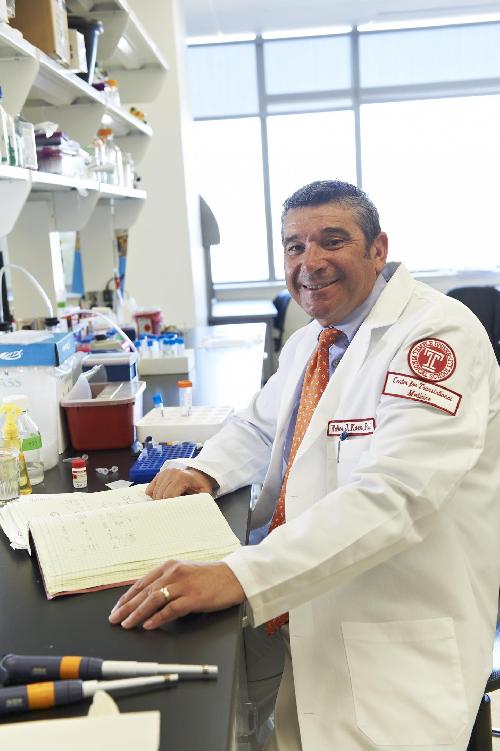(Philadelphia, PA) - When the heart begins to fail, the body does everything in its power to fix the situation. But sometimes, those compensatory mechanisms ultimately do more harm than good. Such is the case with the adrenal hormone aldosterone, which stimulates the heart to pump harder, causing greater damage to the heart muscle. But now, researchers at the Lewis Katz School of Medicine at Temple University (LKSOM) are closer than ever to putting the brakes on that process. With their recent discovery of an unexpected mechanism by which signaling molecules known as G protein-coupled receptor kinases (GRKs) mediate aldosterone-induced heart damage, they have opened the path to an important therapeutic advance.
"It turns out that two kinases, GRK2 and GRK5, contribute to the pathology of heart failure by inducing specific changes in myocytes (heart cells) down-stream of mineralocorticoid receptors that bind aldosterone," explained Dr. Walter J. Koch, PhD, William Wikoff Smith Endowed Chair in Cardiovascular Medicine, Professor and Chair of the Department of Pharmacology, Director of the Center for Translational Medicine at LKSOM and senior investigator on the new study. The report, published online March 2 in the journal Nature Communications, is the first to shed light on the unique interaction.
"When aldosterone binds to its receptor, GRK2 moves to the mitochondria, where it stimulates pro-death pathways, and GRK5 moves to the cell nucleus, where it activates pathways that cause heart cells to grow, making them less efficient," Dr. Koch said.
 This is Dr. Walter J. Koch, PhD, William Wikoff Smith Endowed Chair in Cardiovascular Medicine, Professor and Chair of the Department of Pharmacology and Director of the Center for Translational Medicine at the Lewis Katz School of Medicine at Temple University. Credit: Lewis Katz School of Medicine at Temple University
This is Dr. Walter J. Koch, PhD, William Wikoff Smith Endowed Chair in Cardiovascular Medicine, Professor and Chair of the Department of Pharmacology and Director of the Center for Translational Medicine at the Lewis Katz School of Medicine at Temple University. Credit: Lewis Katz School of Medicine at Temple University
The findings were surprising because GRKs in the heart typically regulate cell signaling pathways based on interactions with G protein-coupled receptors (GPCRs), which differ structurally and functionally from mineralocorticoid receptors. The ability of GRK2 and GRK5 to operate in this so-called non-canonical or non-GPCR fashion adds to a growing body of evidence that suggests GRKs do far more than just regulate GPCRs.
The idea to investigate the relationship between heart failure, GRKs, and hyperaldosteronism (the overproduction of aldosterone) originated with Alessandro Cannavo, PhD, a post-doctoral fellow in the Center for Translational Medicine at LKSOM and first author on the new paper. "Some of the cardiac effects of aldosterone are the result of interactions between mineralocorticoid receptors and the angiotensin II type-1 receptor (AT1R), a GPCR involved in heart failure," Dr. Cannavo explained. "This led us to consider GRK2 and GRK5, which regulate AT1Rs. Both kinases also occur in the heart and are linked to heart failure."
When Dr. Cannavo and colleagues treated heart cells in vitro with aldosterone and looked at the effects on various receptors, they found a direct correlation between AT1R and aldosterone. However, events downstream of AT1R activation were not consistent with traditional GPCR mechanisms. In fact, subsequent in vitro experiments revealed a non-GPCR mechanism, whereby GRK2 and GRK5 are directly involved in triggering pathways leading to cardiac damage via mineralocorticoid receptor activation.
The pathological significance of that mechanism was borne out in studies in vivo, in which mice treated with high doses of aldosterone exhibited increased levels of GRK2 and GRK5, with kinase translocation to mitochondria and the cell nucleus negatively affecting cardiac function. Experiments in aldosterone-treated knock-out mice showed that the loss of GRK2 significantly attenuated cell death along mitochondrial pathways, protecting mice from aldosterone-induced heart damage. The loss of GRK5 was also protective, though to a lesser degree.
Dr. Koch's team further analyzed lymphocytes from heart failure patients to confirm the clinical significance of GRK2 and GRK5 in the context of hyperaldosteronism. Patients taking spironolactone, an aldosterone inhibitor, had lower GRK2 levels in their lymphocytes compared to patients who were not taking the drug. Previous studies had shown that in humans GRK levels in lymphocytes correlate with GRK levels in the heart.
According to Dr. Koch, the findings set the stage for the advance of clinically relevant animal models and strengthen the case for the development of novel GRK2 and GRK5 inhibitors. "Both kinases are implicated in additional pathways that impact the progression of heart failure," he explained. "It could turn out that one drug, possibly a GRK2 inhibitor, would replace three drugs currently used in the treatment of heart failure. Proof for that could come down the road in the future studies."
source: Temple University Health System